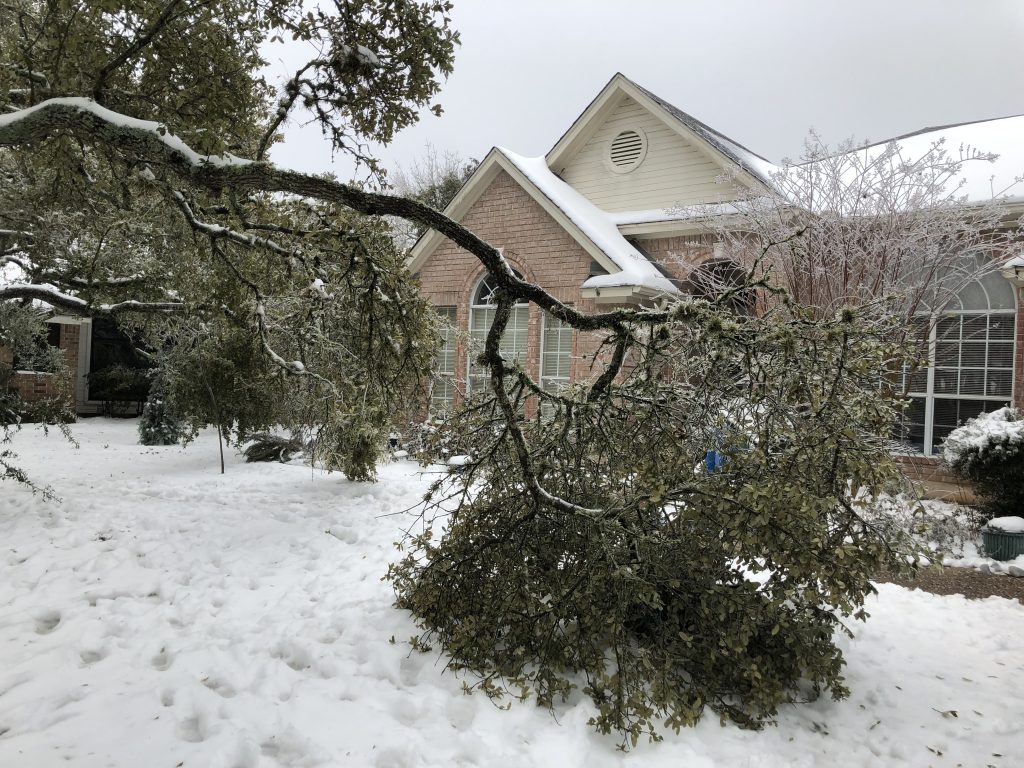As I write this, central Texas is experiencing its worst winter weather event in decades (so what else can I do but write?). Having done tree work here for 40 years now, I’ve seen quite a few cold weather episodes in Austin. There was a five day stretch in December of ’83 where we never got out of the 20’s. Many palms and most tallow trees around Austin froze to death that year, but there wasn’t any precipitation, so breakage from snow and ice wasn’t an issue.

Ice damage to live oak central Texas
A couple years later (’85) we had two events a couple weeks apart that totaled about 7 inches of snow but also pretty bad icing, and we got some breakage with that. In ’89 we got the coldest blast I can remember, down to about 4F, but it was a quick dip, and I don’t remember a lot of breakage with that one. (Am I sounding like an old man yet??) Over my four decades here, I’d say I’ve seen at least 8 ice events bad enough to result in at least some breakage. So they happen more often than you might think.
Okay, so what can you do about it? First, let me explain in a bit of detail what the problem is. The worst hit trees tend to fall into three categories. One: evergreen trees and/or those that don’t lose leaves until spring. This means lots of junipers (I know, you don’t care) and unfortunately, our ubiquitous live oaks. But mountain laurels, loquats, cypresses and other small evergreens that are also valuable often suffer as well. This is of course because the leaves greatly increase the surface area for the ice to collect on. This leads to category number two: trees with lots of ball moss on them. Normally ball moss is not a serious problem for trees (see my post on that), but again, it can greatly increase ice accumulation. Thirdly, trees that have not been well pruned or have structural defects in them.
So pruning your trees properly can definitely reduce the risk of damage to your trees. But in heavy ice events, even well cared-for trees will likely experience at least some damage.
It’s good to keep in mind that most ice-laden limbs will bounce back (literally) once the ice melts. The oaks are particularly resilient. Right now there are live oak limbs touching the ground all over my neighborhood that just a few days ago were 10 feet high! Most of these will not break, and will lift up again once this frozen hell is over. But another thing to keep in mind is that often these limbs will be cracked, and even though they may lift up to near their original position, the cracking may cause a failure in the future, during high winds, or once the branch has put more growth and weight on. These cracks can be completely invisible from the exterior. Frequently these limbs just continue to grow in their slightly lower position. This phenomenon in part explains why live oaks often have branches that grow to the ground. Although this is the natural growth pattern of this species and will happen even in mostly ice-free areas like the deep southeast U.S., the occasional ice event that we experience here in central Texas exacerbates that habit.
Many homeowners here often ask me about the risk of disease, particularly oak wilt, on freshly broken limbs (see my oak wilt page). The good news here is twofold: one, the weather is so cold during these events that no insects are flying to spread oak wilt spores and two, even if it does warm up quickly, the spores responsible for that disease are not at their average annual peaks in mid February (that typically comes later in spring). Another interesting thing is that freeze damage in live oaks can often produce a leaf symptom that is very much like oak wilt. It’s very easy to be fooled by it.
I recommend removing broken limbs as soon as it is safe to do so, removing the least amount necessary to remove the damaged part. Storm damage work is the most dangerous tree work there is. Leaving it to professionals is the best course of action. A competent arborist can also decide whether or not more of an affected tree limb needs to be removed. Broken branch ends should be cut and on oaks should be immediately painted (the city of Austin says within 10 minutes) to reduce the risk of oak wilt spores getting in. Oak wilt is the only common and serious tree disease that can spread through open pruning wounds in central Texas, and for that reason, the Texas A&M Forest Service only recommends painting wounds on oaks.
After this initial damage control pruning has been done, the tree will most likely need to be revisited in the summer, to perform what we call restoration pruning. For more information on pruning in general, see my page and my post on that.
Remember that not all I.S.A. Certified Arborists are competent arborists (truth). Look to my how to hire an arborist page for more info on that.
